Golden State Star Party 2022: A “Working” Star Party
I’ve gone to the Oregon Star Party every year from 1994 through 2019. When I started going, I lived in Portland, and I continued when I was living in Chiloquin in Southern Oregon. OSP at Indian Trail Spring was about the same drive time from each location. After OSP 2019, I moved from Chiloquin to Klamath Falls, adding another 30 minutes to the drive. I was still planning on going to OSP in 2022 - I still think of it as a tradition. But the summer smoke and the fire danger-related cancellation in 2021 got me looking around for other options.
The Golden State Star Party was never on my radar before this year; I’m not sure why. Maybe I only figured on going to one star party per summer. In March, I read about GSSP and realized that it was much closer than OSP (an hour and 45 minutes vs. 4 hours). I decided to register.
Spring went by, and other things occupied my days. Work was a pain, and in June my parents caught COVID and then I contracted it after I went up to help them. It was just a slow motion train wreck, but I still had those days I had scheduled off from work for GSSP. Plus, I think it was the day before GSSP started that OSP was officially cancelled due to road construction. I was still getting caught up at work, so I ended up working part of the Wednesday instead of taking the whole day off. Also, I hadn’t done any preparation for an observing plan. I just threw everything in the car and went.
I wasn’t sure what to expect at GSSP. All I knew was that it was held on a working ranch called Frosty Acres Ranch between the small towns of Bieber and Adin, California. It was an uneventful drive that took exactly as long as Google said it would. I pulled in the gate after 6:30pm, and there was nobody at the checkpoint. The parking and observing areas were laid out with cross streets named for planets. It looked like the outer solar system and Oort Cloud were pretty packed, so I settled for a space bordering Mars.
There was a “meet and greet” at the main tent at 8pm. My impression was of a pretty loosely run event. (If you have a problem with your neighbor, try to work it out. The committee and volunteers don’t want to be police.) I recognized a few faces from OSP, but I’m not extremely social so most were unfamiliar. Rich Ozer seemed to be the dynamo making things go. The GSSP is held on a working ranch owned by the Albaugh family, and Rich said that the previous night they had been working all night baling hay under bright lights. Since that was finished, we could look forward to dark skies.
Eventually the sun sank and I prepared to observe. I planned to keep to myself the first night and just enjoy being under the stars. Astronomical twilight ended at 10:50pm, so it was a bit of a wait for darkness. There was a bit of smoke or haze low over the Cascades, but otherwise the sky was clear. When it was dark, it was decently dark. On Wednesday evening, my SQM-L averaged 21.64 at the zenith. I got my SQM-L after the most recent OSP, so I can’t compare numbers. What I can say is that the GSSP site lacks the remote feel of OSP. Lights are directly visible from Bieber in the west, along with occasional headlights from traveling vehicles that could be quite annoying. The light dome from Redding was visible, but not too much of a problem. The north toward Klamath Falls wasn’t that great, but from my setup spot it was partially blocked. I could see a low light dome in the southeast, probably from Susanville and Reno. The southern horizon wasn’t awesome; there’s a low hill to the south of the observing site, but if it wasn’t there, Sacramento’s light dome might have been visible. Alturas didn’t seem to be much of a problem to the northeast; again, there were a few local lights visible in that direction.
The first night ended up being the most transparent; however, seeing was mediocre and I also think my scope lost collimation without me being aware. My first real target was comet C/2017 K2 (PanSTARRS). The comet was passing over a pair of stars while I was observing it; even though the stars were only magnitude 11-12, they diminished the view of the coma a bit. The comet had a bright nucleus with a fountain projecting to the southeast. The tail proper pointed northward and was fairly broad.
I messed around with some familiar objects and some obscure objects before sketching IC 972. This planetary nebula in Virgo (!) ended up on the observing challenge list for GSSP and was described as “relatively easy but little-known”. At 104x with an OIII filter, the planetary popped in and out of view as a ghostly round form. Changing magnifications and filters didn’t really improve the view. The nebula was marginally visible with no filter. It was difficult to discern any structure or shape, but the object seemed to be brighter on the west side.
More messing with Messiers, etc., and then I decided to call it a night at around 2 am. The temperature dropped as it does on the high and dry side, and I was a couple of layers shy of being comfortable. I just rolled into my sleeping bag in the back of my car. I got an assist from the giant 5th-wheel parked to the east of me in that it blocked the morning sun and allowed me a reasonable amount of sleep. I put my sun-shade up and slept a bit longer. There was a swap meet at the tent, but I wasn’t buying or selling. I ended up napping for much of Thursday. OSP often has speakers on the hour throughout the afternoon, but GSSP was limited to one evening speaker, so as far as on-site organized activities it was minimal. It’s much more convenient for people at GSSP to go into the towns of Bieber or Adin than it is for someone at OSP to reach civilization. I thought about going somewhere but decided to just rest around camp. I enjoyed the activities of the local Horned Larks as they foraged for grasshoppers on the field, along with the occasional flyby of other birds, dragonflies and butterflies.
 |
| Horned Lark |
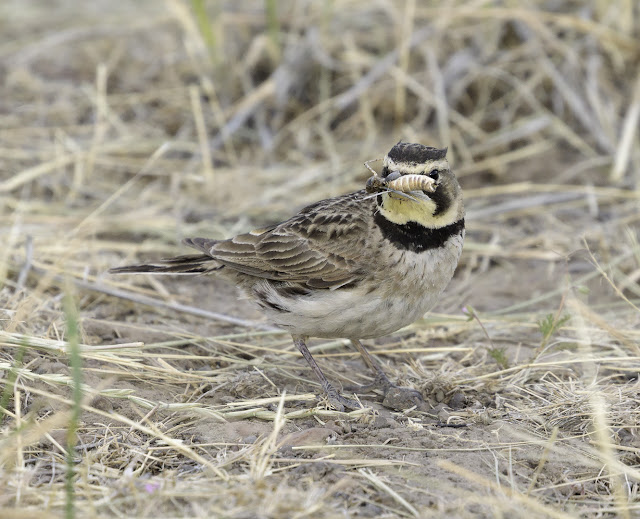 |
| Horned Lark with a grasshopper |
Daytime temperatures stayed reasonable, in the mid 80s. Camped to the west of a large 5th-wheel that turned out to belong to Chris Tribe, I slept in my car and was shaded from the early morning sun by that rig.
 |
| Mt. Shasta from the edge of the star party field |
Thursday night was another clear night. A thin crescent Moon was visible during twilight. In darkness, I focused on the southern horizon. I had Sue French’s Deep Sky Wonders book with me, and jumped around on some of the tours. One of them included the globular NGC 5986 in Lupus and the planetary nebula NGC 6072 across the border in Scorpius. I sketched NGC 6072, which I found to be a nice planetary. Immediately visible at low power, it showed a soft gray roundish disk over 1’ in diameter. At 165x + OIII filter, it looked a little more irregular, elongated slightly SE-NW. There was a hint of a partial inner ring on the W side. It also looked like it could have a bilateral structure. A bright spot just S of center seemed to be more prominent with no filter or with UltraBlock instead of OIII, so that might be a star. The partial inner ring was irregular; different magnifications and filters gave different perspectives.
It wouldn’t be an early summer night without a look at The Bug Nebula (NGC 6302) in Scorpius. This is such an interesting object with both coarse and fine details. I did a sketch and made the following notes. On first impression at mid-high power, it looked like a spiral galaxy with a bright core and extensions off both sides. Raising the power to 330x and adding the UltraBlock filter, the dominant impression was of a very bright core. The nebula was broken and mottled near the center, and the core elongated N-S with small bright spots. The extensions were curved, one to E and then curving southward (counter-clockwise) spiraling out from the core. A short V-shaped extension led W from the center, with the opening toward the core and a bright (stellar?) spot embedded. Farther out to the W, there was a discontinuity/dark lane, and then a further thin extension. Overall, the nebula showed a very high surface brightness.
I also viewed C/2017 K2 (PanSTARRS) and noted that the comet was more obvious in binoculars than the night before. In the 10” at 47x, the comet showed a round coma with a stellar nucleus offset slightly to the W. The bright inner coma featured a couple of jets that were more easily visible at higher power. The tail stretched northward for at least 30’. More detail was visible in the coma at 104x. A broad fan-shaped jet/fountain extended to the ESE beyond the border of the coma. The tail broadened out until at 10’ it was as broad as the coma, and showed a couple of linear spine features. The tail petered out at 25-30’ distance.Overall, sky conditions were not as good as the previous night. The transparency started out pretty good and then got soft and not extremely contrasty.
As an introvert, I tend to spend most of my time at star parties observing through my own scope. But since Chris Tribe (Black Hole Mobile Observatory) was camped next to me with his 34” f/2.9 scope, I had to check out some views. The scope is impressive even though it is still in the fine-tuning stage. Color on NGC 7662 (The Blue Snowball) was very vivid and saturated, and M51 showed off its spirals in all their splendor. I also got to see Comet PanSTARRS in the scope. Chris also has a 20” f/4.5 with a Zambuto mirror, and it was impressive to see Saturn’s moons. Rhea, Tethys and Enceladus were lined up diagonally from above to the side of the rings. I wasn’t able to make out Enceladus in my 10” with 19-year-old coatings.
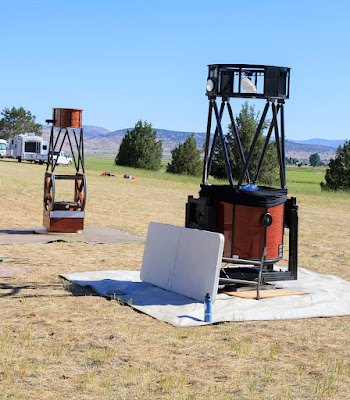 |
| Chris Tribe's 34" (front) and 20" telescopes |
On Friday, I took the opportunity to go into the forest and visited Ash Creek Campground. I parked at a trailhead near the campground and walked along the creek. I had thought about purchasing a fishing license and visiting some of the Northern California trout streams, but due to my compressed schedule I left my fishing gear at home and visited this nearby spot with my camera. It was a nice respite with some shade and I got a few pictures of damselflies, dragonflies and butterflies. I did meet one angler who said he had caught a couple of fish.
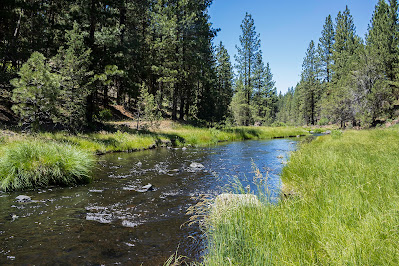 |
| Ash Creek near Ash Creek Campground |
 |
| American Rubyspot (Damselfly) |
 |
| Grappletail (Dragonfly) |
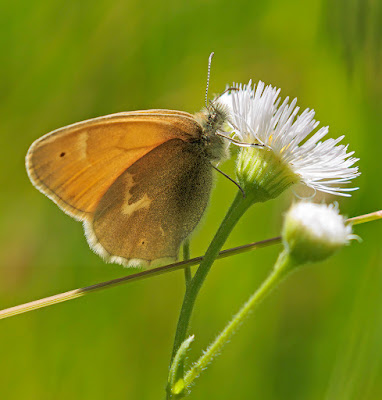 |
| Ochre Ringlet (Butterfly) |
Back at the star party, I didn’t win any of the door prizes. Friday night was a public night with a few visitors from the nearby area. Unsurprisingly, nobody stopped for a view through my little scope. My targets for the night were more southern horizon objects along with some high in the west. In the south, I visited the globular NGC 6541 in Corona Australis, as well as another bright globular NGC 6388 in Scorpius and the dimmer NGC 6496. I revisited the remarkable field on the Sagittarius/Corona Australis border with globular NGC 6723 and an assemblage of nebulae. In the west, I poked around Canes Venatici. NGC 4111 is a small, high surface brightness edge-on galaxy that shares the field with a much lower surface brightness, rounder galaxy—NGC 4117. I enjoyed the view at 330x. Sue French’s book showed NGC 4151 on the map of one of the starhops, but as I approached the field I saw a larger, low surface brightness galaxy that wasn’t on the map, as well as a smaller galaxy next to NGC 4151. NGC 4151 itself wasn’t anything special; dominated by a bright core, the rest of the galaxy was dim. But the field was nice. Consulting a deeper map after the fact, I identified the large galaxy as NGC 4145 and the dim companion as NGC 4156. Had I researched beforehand, there were another couple of very faint galaxies that I might have pulled out of this view. Same with the NGC 4111/NGC 4117 field. There are galaxies beyond galaxies in that region of the sky.
Tearing myself away from my scope, I visited Ed Allen’s 24” f/2.75 scope “Elvira”. This is a marvel of engineering and automation that I saw at the last OSP. But I was particularly interested in the views through the PVS-14 night vision monocular connected afocally to the telescope. Ed was showing the Cat’s Paw Nebula (NGC 6334 and surroundings), and the view was extremely contrasty. I can see vague patches of nebulosity in my 10”, but the image intensifier brings all the light and structure forward, with the capper of a very dark nebula that stands out starkly. Other night vision targets were the Crescent Nebula, the Pillars of Creation in the Eagle Nebula, and a higher-magnification view of The Blue Snowball.
Saturday was a free pancake breakfast prepared by the GSSP Committee. Apparently this is a cool tradition that happens every year. Weather was supposed to be iffy, and I wasn’t sure I was going to stay for Saturday night. Lots of people left, and others stayed but planned more on socializing than observing. I decided to stick it out. While I was setting up, I was approached by another attendee who hoped that I could share some views with some members of the Albaugh family who had stopped by. Most scopes were gone or taken down, but he figured I might be available with my little Dob. It was very bright twilight, but the Moon was accessible, as were some double and colorful stars (Albireo, Double-Double). Another highlight was a spark-shedding fireball in the south that lasted long enough that I could point and get everybody to turn around to see the end of it. The visitors stayed until it was just dark enough to get marginal views of a few deep-sky objects like M13, M6 and M17. I was glad to provide the service.
Saturday night skies were partly cloudy after some gusty winds during the day. There were distant thunderstorms in a couple directions, mainly over the Cascades. The Moon was up until after 11pm, but skies overhead were still okay. I didn’t do a lot of serious observing. Comet PanSTARRS was still looking good.
 |
| Lightning illuminates clouds to the west |
 |
| The Milky Way from Scutum through Scorpius |
Seven seconds of Mars: I woke up to go to the bathroom in morning twilight. I hadn’t broken down my scope, so it was still available. I looked at Jupiter and the view was okay. I looked at Mars and saw a surprising amount of detail on the tiny gibbous disc, just 7.3 arcseconds in diameter. The South Polar Cap was small and bright, and the dark features of Mare Erythraeum, Aurora Sinus and Margaritifer Sinus were near the central meridian. Seeing was better than average. I threw a polarizer on to darken the sky and also added a Baader Contrast Booster filter. I got the Contrast Booster after the last opposition of Mars, and have had mixed to poor results with it on other targets. But it seemed to improve Mars at least somewhat on this occasion. I kept the magnification at 330x while sketching for fear that if I went higher I might lose the planet in the bright twilight. I finished the sketch just before sunrise, and that was a great end to the star party.
My overall impressions of the event were positive and strongly colored by the good weather. I don’t think the site is a truly great dark-sky site (more of a true Bortle 3 site), but on any given night the influence of haze, airglow and other factors can make a pristine site into a mediocre one. It has been really rare recently to have conditions that would let Indian Trail Spring shine during the Oregon Star Party. So perhaps it’s good to have a site that’s consistently available and accessible for a large gathering-style star party and leave the remote sites for smaller parties where dates can be adjusted as needed to accommodate the weather. I also appreciated the limit of 250 attendees; with 400 the site would have seemed a lot more crowded although still acceptable. Will I go again next year? I’ll at least consider it.
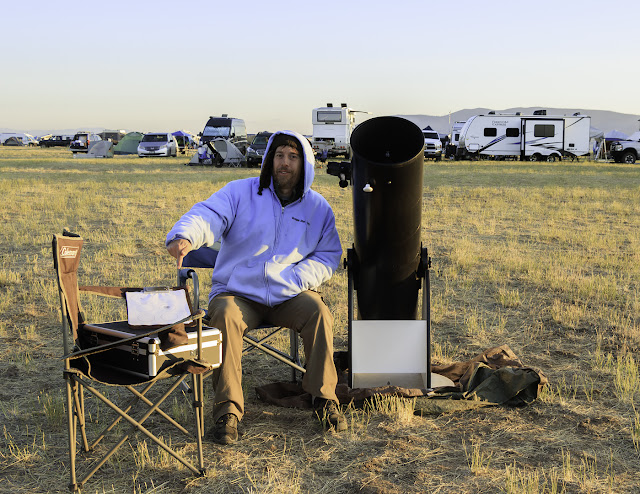 |
| Observing right through to sunrise like a true O.G. |


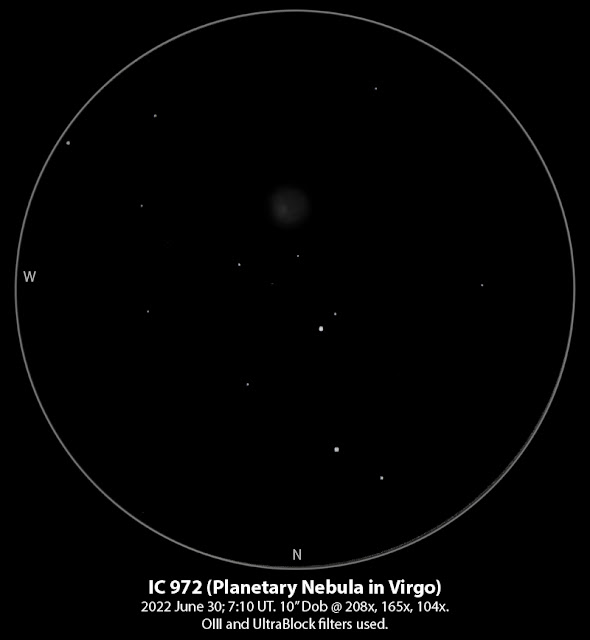
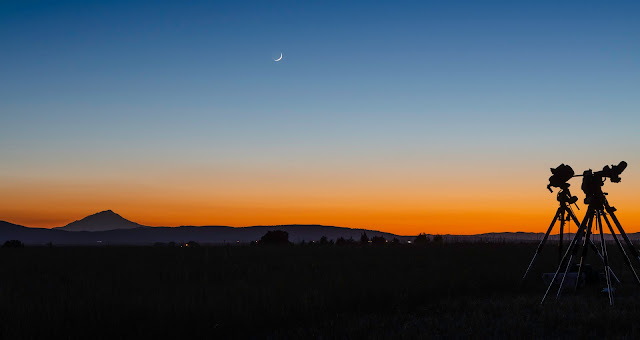

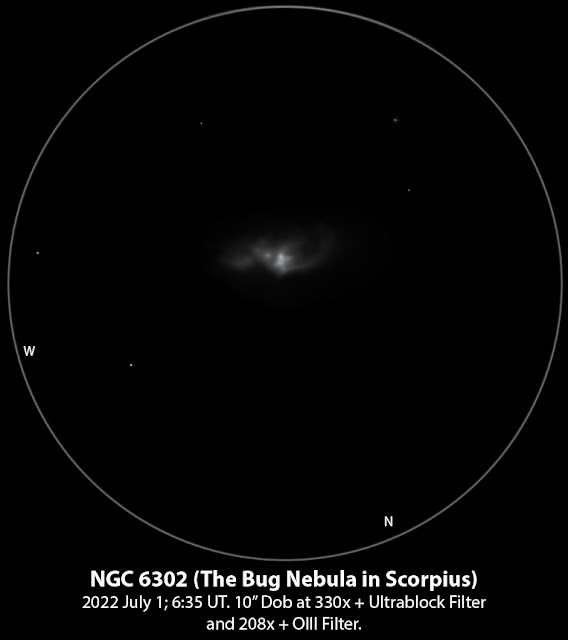



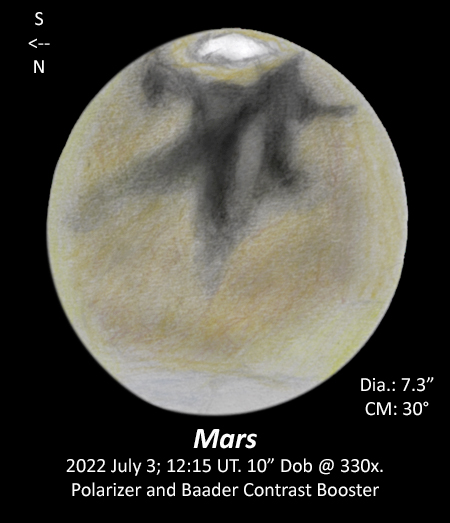


Comments
Post a Comment